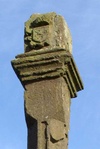- A
- B
- C
- D
- E
- F
- G
- H
- I
- J
- K
- L
- M
- N
- O
- P
- Q
- R
- S
- T
- U
- V
- W
- X
- Y
- Z
| Fettercairn Mercat Cross |
|---|

Fettercairn will have had some kind of market cross since 1504 when the status of a free burgh of barony was first granted. It is is said by some that the shaft of the current cross originally stood in the burgh of Kincardine which declined and eventually ceased when the judicial headquarters of the county moved to Stonehaven in 1600. There is no historical record of the cross being moved in this manner. |
| Fettercairn the Royal Arch |

A triumphal arch of Rhenish Romanesque style; round arch between two high buttressed octagonal towers with short gabletted spirelets and wrought-iron finials. The top of the arch is finished with a crenellated parapet with a curvilinear gablet feature at the centre. It was the winner of a competition, assessed by Queen Victoria, to commemorate a visit by Victoria and Albert in 1861. More Information |
This content was submitted by external contributors and does not necessarily reflect the views of the University of Aberdeen.
